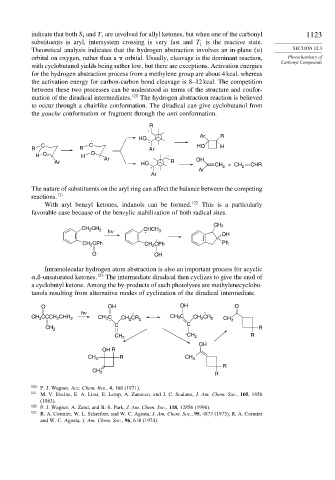Page 1138 - Advanced Organic Chemistry Part A - Structure and Mechanisms, 5th ed (2007) - Carey _ Sundberg
P. 1138
indicate that both S and T are involved for allyl ketones, but when one of the carbonyl 1123
1 1
substituents is aryl, intersystem crossing is very fast and T is the reactive state.
1
Theoretical analysis indicates that the hydrogen abstraction involves an in-plane (n) SECTION 12.3
orbital on oxygen, rather than a orbital. Usually, cleavage is the dominant reaction, Photochemistry of
Carbonyl Compounds
with cyclobutanol yields being rather low, but there are exceptions. Activation energies
for the hydrogen abstraction process from a methylene group are about 4 kcal, whereas
the activation energy for carbon-carbon bond cleavage is 8–12 kcal. The competition
between these two processes can be understood in terms of the structure and confor-
mation of the diradical intermediates. 120 The hydrogen abstraction reaction is believed
to occur through a chairlike conformation. The diradical can give cyclobutanol from
the gauche conformation or fragment through the anti conformation.
R
.
Ar R
. HO .
C C HO H
R R Ar
H O H O . Ar .
Ar HO R OH
. CH 2 + CH 2 CHR
Ar
Ar
The nature of substituents on the aryl ring can affect the balance between the competing
reactions. 121
With aryl benzyl ketones, indanols can be formed. 122 This is a particularly
favorable case because of the benzylic stabilization of both radical sites.
CH 3
CH CH 3 CHCH 3
2
.
hv
OH
.
CH CPh CH CPh Ph
2
2
O OH
Intramolecular hydrogen atom abstraction is also an important process for acyclic
,ß-unsaturated ketones. 123 The intermediate diradical then cyclizes to give the enol of
a cyclobutyl ketone. Among the by-products of such photolyses are methylenecyclobu-
tanols resulting from alternative modes of cyclization of the diradical intermediate.
O OH OH O
hv . .
CH CCCH CHR 2 CH 3C . CH 2 CR 2 CH 3C CH 2 CR 2 CH 3
3
2
C C
CH 2 R
.
CH 2 CH 2 R
OH
OH R
CH 3 R CH 3
R
CH
2
R
120 P. J. Wagner, Acc. Chem. Res., 4, 168 (1971).
121
M. V. Encina, E. A. Lissi, E. Lemp, A. Zanocco, and J. C. Scaiano, J. Am. Chem. Soc., 105, 1856
(1983).
122 P. J. Wagner, A. Zand, and B.-S. Park, J. Am. Chem. Soc., 118, 12856 (1996).
123
R. A. Cormier, W. L. Schreiber, and W. C. Agosta, J. Am. Chem. Soc., 95, 4873 (1973); R. A. Cormier
and W. C. Agosta, J. Am. Chem. Soc., 96, 618 (1974).

